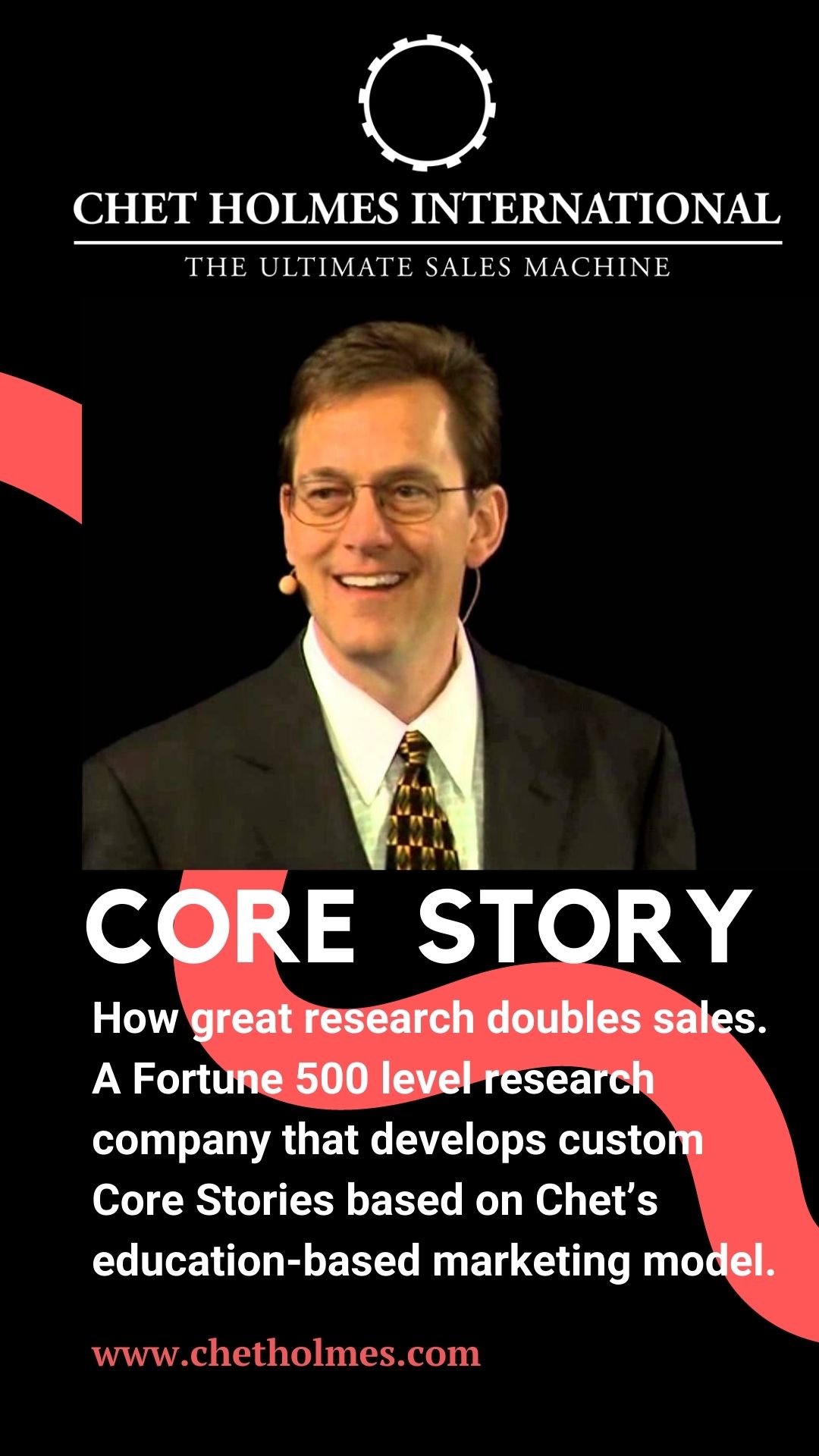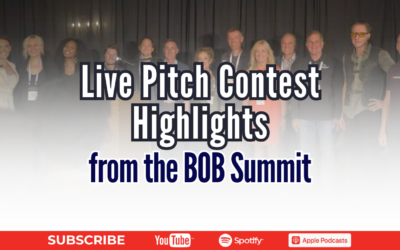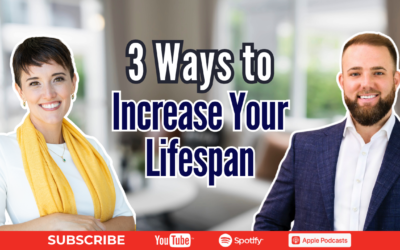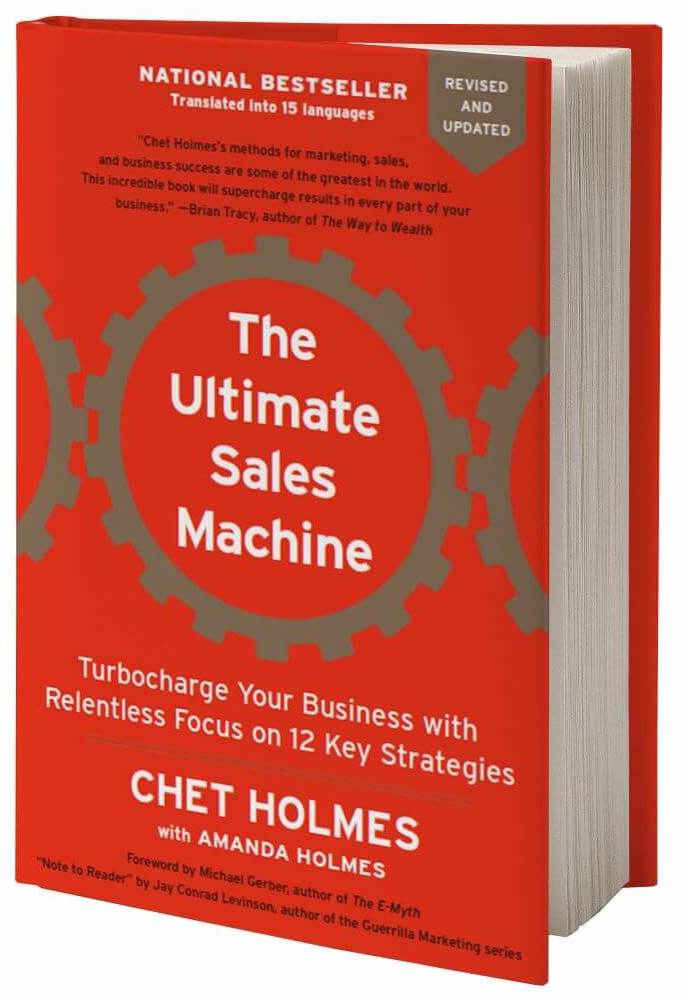This week’s episode is never before released recording of my father Chet Holmes hot seating a client on:
- How to structure pricing for a consultative sale
- How to create a commission structure for sales reps
- Case studies of other successful clients and how they used education based marketing to generate double the leads into their business.
Listen in for some tips on how to build a powerful sales process to help you maximize your success
- Want to know what’s keeping you from doubling your sales in the next 12 months? Take our quick QUIZ to get answers: Howtodoublesales.com
- If you’d like to have a profound breakthrough in your business, schedule your breakthrough call with a LIVE expert here: Chetholmes.com/Breakthrough
- Claim your FREE chapter 4 from the top 10 most recommended marketing and sales books of all time! Visit: Ultimatesalesmachine.com to find out how you Create 9X More Impact from every move you’re already making to win clients!
TRANSCRIPT:
*this transcript was mostly generated by AI, please excuse any mistakes 
Let’s go with Dick Battenberg info. Be Dick. If you’re there, say hello? Hello. Hey Dick. Hey, how are you, Chad? How you doing? So tell me what it is that you do. We have an information technology group of consultants that provide information in the form of business intelligence, three primary industries.
One is the cable industry. The other is telco, which are they’re very the same and and utilities all having to do with operational efficiencies customer care and and of extending their lead over competition. Okay. Gimme a specific example of something you do, people. What we do is go in and typically it.
Organizations have silos of it and they don’t talk very well. So finance probably doesn’t talk to sales that doesn’t talk to marketing that doesn’t talk to call center that doesn’t talk to whoever on down the line. And because of that they don’t have the full picture of what’s going on with what’s happening out in the field with truck rolls to do installations with customer care.
that’s taking orders for installs and disconnects. They all don’t share sales metrics or campaign management, or even warehouse management or billing, installs and things. And you have a program that does all those things. What we do is based on what the customer, when we go in and try to figure out the pain, they’ll usually have one or two that, that are really bothering them.
And so what we do is provide the interface between the silos of information to give them timely business intelligence so that they can make decisions on how to improve things like number of calls per day, that their techs are making to install or de-install product. What’s the cost of something like this a truck roll or our cost.
The what you charge them to do this for them? Typically we’re on an hourly fee for consulting and it ranges anywhere from say 150 to 200 an hour, but the average project will be 50 hours, 500 hours. Probably in the area from 250,000 up hours or dollars. Yeah. So it’s a quarter of a million dollar investment, but what’s your, how do you sell it?
Do you sell stage one, which is like an audit and investigation and then how do you sell it exactly right. What we do is get them on the phone. Maybe they’ve heard of us. And our pitch is to do with getting their arms around operational efficiencies and improving margins. And we’d like to come in and do a discovery session, probably take a week or two, depending on the number of part departments that we have to talk to.
How would you charge for that? Depending on the length of time it would be an hourly charge or what we’re working on now is in our core story, when they go to. The Batman commercial at the end. We’re gonna offer a week at no charge to do the investigation of pain where we’ll go talk to everyone and see what’s the okay, biggest thing.
I don’t recommend the no charge. Okay. Cause if people don’t pay, they don’t pay attention. Agreed. I recommend that you would put a higher charge on it and give them a special to get them to go now. Okay. Say it’s $10,000. Normally we charge $10,000 for one of these assessments and blah, blah, blah, blah, blah, blah.
But right now I’ve got a couple of guys that can put on this and if you can make a decision and the next seven days, I give this to you for only half, for only 5,000. I like it. And the other thing is with this model, which I’m very familiar with, we’re working with a company right now that does power monitoring.
They have devices that monitor the quality. Of power and for electric companies, okay. They’re already going to all the utility companies and they have a great core story and it’s aimed at the CEO, but it’s probably not as impactful as yours, cuz really ultimately what they’re looking to do is, get these little devices in the hands of their engineers.
But what their situation was, just explain it. And there might be some synergy here because your core story should be more powerful than theirs. Because you’re covering all the areas. They really only cover one area, but we fated up their core story to talk about areas that got them in there.
For example one of the things that happens every single day, by the way, every single day, someone dies trying to monitor. Every single day, 365 days a year. A technician gets killed, gets electrocuted, trying to monitor power. And the average lawsuit for that is, millions of dollars. So when they get a CEO on the phone, they’re using things like, look, we are gonna help you reduce litigation.
We’re trying to make it sound like it covers a broad area of stuff, but really it covers this, this main thing that they cover. And then of course they have lots of stuff about the power grids and how they’re old and antiquated and, collapsing and blackouts left and right. And government regulations.
And so it is pretty cool. Did you build your own core story or did you have one built for you? Oh, you guys build it. We worked with your folks and our our coaches Jim Castillo. Doing a good job. And and then Erica, I don’t have her last name, but she’s been very diligent in helping us through a real tough core story.
Cuz we have so many things that we do. Yeah. It’s tough. I can tell you right now. Yeah. Yours is hard . So what I would do is, you have that part where you come into an now word from our sponsor , and then you talk about yourself and what you do and how you do it and how you’re solving some of the problems that you’ve just been laying out for the last half an hour. Yes. If your core story is structured properly, that’s how it should be. Sure. And then and then it says something like one of the things that we do is we show you how to solve all these problems.
And we do this through a diagnostic process. That diagnostic process would include. And now bullet complete investigation of all your silos of information, bullet specific recommendations on how to communicate effectively between these silos bullet. And I’m making up stuff based upon what you told me, but your bullet should be way better than mine, right?
Cause you know what you’re selling, but it should sound tasty, delicious, like irres. , you know what I’m saying? If I’m a high level executive at one of these telcos and you are, showing me this and you’ve put enough, you’ve put me in enough pain, my brain’s already wanting to buy. I’m already wanting to make a decision.
I already wanna buy something. Please put something in front of me. If your core story is good, it makes the prospect want to buy something because you’ve put ’em in enough pain that they’re going, okay. I wanna make a decision here. Just put something in front of me so I can make a decision, and and then at the end you say, and then here’s how we proceed with that audit.
Normally we charge a flat fee of $10,000 to conduct these audits. But right now we have a special going on that. If you can make a decision in the next seven days, you can get that for only 49 95 . Okay, good. And then the other thing it does for you. is, it gives you self-funding growth strategy, because I would imagine that the same guy who sells it is not gonna do the diagnostic work.
Correct. We turn it over to a project manager with experience in that particular industry. So you might as well fund the activity out of the sales process. So what you do is you take, and you say to the sales guy, so you get yourself a bunch of Che juniors. This is how you can ramp yourself up.
If that core story is good, what you want to have is you want to have, 3, 4, 5, 6 sales people with that core story, delivering it to every person, every chance they get every chance they can, and then they get 2000 bucks of the 5,000. The other 3000 goes to you for cost and operations and expenses and the actual, audit itself, which is expensive.
I’m sure. And then I don’t know how much of the back end sale you pay reps. That’s up to you, but. It’s a quick kill as compared to waiting for you to close some quarter of a million dollar deal, then you have to. So in other words, if I’m a sales guy and I go to work for you and I’m Chet junior, I’m 22 years old, but you’ve gotta Barracuda killer core story.
And I can go out and present that thing. And I can present four or five of those a week, which is not. Not even that much, some sales organizations require. And I think Jim told me you have some pretty heavy sales background yourself. Some organizations required to make at least 10 in face, face to face meetings a month, a week, two a day.
Yeah. Yeah. So you say, if you just do five, you should close one out of five and that’s $2,000 a week, that’s $8,000 a month that doesn’t even count your back end when we close the quarter of a million dollar deals, that just counts your front end, but it’s a damn good front end and it’s instant boom.
Every time you make a sales call where the guy says, yes, you get 2000 bucks and it builds on itself too. Once you do one and you see how easy it is, you’re gonna go. Gonna want to go do another one real quick? Yeah. So I would definitely charge if you can justify the value of it, and so I would have what you.
and then I would have, and maybe that’s, two panels of four or five bullets that explains your process and it sounds all benefit oriented. And then the last part is the results of this will be, you’ll have a path to know how to do this. You’ll have a path to know how to do that. You’ll have a path that will help you reduce this cost.
You’ll have a path that help you reduce that cost. That it’s all in a sequence of things. That’s how that’s how I would structure that for sure. So let’s talk about the core story. Read me your areas covered or aren’t you that far along? No, I’m pretty far along. I just need to get right to the.
To the core story. Give me just a second. The area’s covered just for everybody else, listening. That should be a all sizzle, no stake. So when that last one where I read it and it said what’s a one additive you can put in your soil that will do this and do that. That’s selling, that’s not an areas.
You do not put, selling. Makes me crazy. When I see an areas covered that starts to sell the product before we even, or that even explains a specific trend because the areas coverage should be all sizzle, no stake. It should be sound really good. And I want to know the information in there, but it’s not telling me like, if it says the five most dangerous trend and then it starts listing trend, number one, now my brain, if I’m a sharp guy and I’m busy and you’re gonna tell me how bad the economy is and you’re number one trend is how the economy is bad.
I’m gonna go, you know what? You can skip that part. Cause I already know that. So you want to have areas covered. That is mysterious, but sounds really tantalizing. Okay. I got page out. And since all three of these industries that we’re in right now our monopolies we have our first point is the monopoly money is running out.
and me meaning that competition is chomping at their heels and also customer care is causing them to lose business. That’s the meaning of it. It’s not on the slide. Second point is many executives are literally disconnected and we get into that more with the information that we provide from, as I explained, connecting the silos and providing the business.
Okay. But in your areas covered it should say it should spell that out just a little bit more, many executives are disconnected or how executives have no idea about the information that helps them make better decisions or how executives are missing key data. That enables them to make effective decisions about running and effectively managing the business and reducing costs, so it’s mysterious and it sounds good.
And if I’m an executive and it says how key executives are, not getting the data, they need to effectively manage the business. I’d be like, okay I’m interested in that. Show. Show me that. Okay. Read the next bullet. The next one is exposing the five biggest failure points of profitability.
Okay. That sounds great. That’s perfect. That’s a perfect bullet because it’s vague. It’s mysterious. And yet I want to know the answer. Okay. Next that is now is the time for a wake up call. Okay. That’s not as good. No, that last one is perfect. Okay. So maybe four should be some, is there a fifth or is that it?
There is a fifth and it’s the five steps to success. Okay those are vague. I think four could be better. I think it should be something like, what all this data means to you or how you can use this information to be more effective as an executive. Okay. Something like that. And then five says five easy steps you can take.
That’ll change everything. Okay. But it does sound good. And it does sound like they’re going in the right way. The thing is, again, that what I like to have people do is force you to think about, have you seen the little threefold brochures that are, have been designed from the core story?
Have you seen any of those? I, Jen I don’t remember seeing them if I did. Okay. Ask Jim. And any of you listening, ask your coach. If you want to see the one we built for Mercedes. It’s fantastic. Then there’s one we built for a fitness chain. Okay. Chain fitness stores. So these are where we’ve taken.
The Mercedes course story is 187 panels. Okay. Obviously, no one is ever gonna sit through 187 panel core story. And in their case, it’s a training tool. They use it to train new sales reps, but then the sales rep carries in their inside jacket pocket. A little, I think there’s is actually a fourfold, but it, you know how if you take an eight and a half by 11 piece of paper and you fold, you turn it sideways and you fold one in the other end on top of it and you have to have let’s a little threefold.
And that actually gives you six panels where you can put information. Okay. So I would say the great exercise is to force yourself of how could I put this in a brochure? And the brochure wouldn’t be called a brochure. It be called a special report. That’s why I want you to see one of these. And again, any of you listening, just have your coach ask the head coach.
So I don’t get 16 coaches asking me for this, but I will send these. And I’m pretty sure the head coach has these anyway, but I will send the these two brochures. I might be able to find a third and a fourth one. But those two, I know recently, I just used them for something else as an example. So I know I can lay my hands on them, but the Mercedes brochure and the fitness chain brochure, and we took massive core stories, full of great information.
And on the front cover, the Mercedes one says the six most important things. Everyone needs to know before they buy a car. It doesn’t say the six things you need to know about Mercedes. It does not say that. And then when you read it, it starts talking about safety. And then by the way, most people don’t know this, but Mercedes invented safety.
You think the Volvo is safe, they didn’t invent anything. The Mercedes invented the seatbelt, they invented the crumble zones. They invented anti unlocking brakes. They invented air airbags. Almost every major safety advance was invented by Mercedes. Most people don’t know that the sales people didn’t even know that we taught them that.
Are you using that as a leave behind or a pass out of a show or what? All the above. Okay. All the above or when, someone’s not gonna sit through that core story. You’ve got a fantastic little handheld mini core story. But yours would be called, a special report for telco companies.
Okay. And then this way it can be used at a trade show. It can be used, when someone won’t sit through an elaborate thing, but here’s why I want you to do it. Cuz it forces you to use only the best information of your core story. Okay. What are the five points I had? I just tested a new copywriter who obviously read my stuff.
And I told him, give me a pitch on the book, like why people wanna read my book, this guy’s interviewing for a job. And I said, I just wanna see how he writes copy. So I said, give me an example of why someone wanna read my book. And he wrote a paragraph first about the state of the world and then pitch the book.
Okay. So that’s basically what a core story does it first talks about what’s going on in the world that makes your thing important and then it pitches it, but it pitches it in a way that still educational. So never says why you should hire us. It says the five things to look for. If you’re going to get this problem fixed, here’s the way you do it.
And then it’s explaining all the stuff you do without ever pitching you. Oh, it’s what it’s. It’s a good hook. And then in the end it goes now a word from our sponsor, and that should be the shortest part of the whole core story, because you’ve already done all the heavy lifting that should say, by the way, everything that we just taught you, we do all that.
. And that end part should be five panels, 10 at the most, I see these core stories were the 30 panels of a pitch on you. That’s wrong. Yeah. That’s what I was afraid we were doing. We were trying to. Do a sales pitch at the end. And probably that’s not what it’s set up to do well again, if the core story is right, it’s gonna teach me everything you do without even telling me it’s all you.
Because what happens is when you do, when the whole idea is you’re gonna call Patel topic level executive, that’s who you need to be at right. Need to be like CEO level for your pitch. Am I right? Yes. In an ideal world, you would love to be with the CEO of the company. So you can say. you can say, look, there are eight silos of information that dramatically affect how your business is gonna function, making it as efficient as possible, making it as profitable as possible and avoiding some of the disastrous mistakes and things that can like literally ruin companies and take them from profit to laws.
And so our company, which has been, serving the telco market for X number of years now, we, we commissioned a study on this and when we found the information, we thought, boy, this is so compelling. We put this into a executive briefing and we’re gonna be showing that to at and T and we’re gonna be showing that to Verizon.
We’re gonna be showing that to making up names here, them better than me. And so when you’re talking to other big players, you mention the other big players, you’re gonna be showing it to. And in fact, if you have the names of the CEOs of those companies, it’ll help you even more.
And we’re showing it to David Branson. At, and T we’re showing it to, Jackie Chan and I’m making up names now it’d be fun, Jackie Chan the head of Verizon and, and if you can mention the names of the CEOs, you’re gonna be showing this to, and, or you can say let me see other people on our list are, cuz remember you always wanna be telling the truth.
And then when you get, what’s another big telco company. Oh, T-Mobile yeah. When you get T-Mobile now you should have no problem getting at and T and Verizon and and there’s thousands of little telco companies now left and right. And right. And left. But that’s where the competition’s coming from.
Yeah, exactly. And for you tell other side of the business, right? Yeah, sure. Of course. For you though, the big opportunity is in all those other ones. So what I would say is when you promise you’re gonna come in and give me an executive briefing, you have to live up to that first So if your core story is, let’s say 80 panels. 90 at the most, because if you’re doing two panels a minute, you’re gonna do 45 minute, maybe in lunch and learn, or an executive briefing. And you tell ’em look, it’s 43 minutes. You want to try and make it sound precise. You say it’s 43 minutes, but with Q and a most people allow an hour.
And, and then also remember your fallback should be to offer lunch and learn because those are easy to sell and come in and cater your lunch. Your case, you’re going for such big deals. It’s not a big deal for you to bring in lunch. Sure. Who cares? It’s gonna cost you a hundred dollars or something, 200 bucks.
If they bring a whole staff of people in there, five people for you to present to. When you’re offering to teach me how I can run the eight silos of my business with greater effectiveness in ways I couldn’t possibly imagine. And I should see that right now, because these things are gonna dramatically affect my profitability.
And you do this as a service to the market, because after you saw the results of the study, you commissioned, you were shocked and you knew. This executive had to see it. And I’m writing your pitch for you right now. I hope you realize like that’s your pitch, take a notes. yeah it’s recorded so you can get it from your coach and go back and take it word for word, cuz that’s strong stuff.
I just gave you that strong copy and and then you should have a writeup that says that, and then you should have, go to some of your current clients and get letters that say that, and so this way you’ve got all kinds of tools in your arsenal and Marshal your sales effort around that compelling offer to teach them something of extreme value.
And if they say, what do you get out of it? You say what we do is we help companies in some of these areas and what we get out of is a public relations effort. It’s how we meet executives like you, and and heck we, we know a lot of people in the industry, I’m sure you’ll find it valuable and and then you go for the close and then when you get in there, After a while after showing them all these problems, then you say, so what are some solutions?
And you go there’s five ways to do this one. You should have this data, in integrated fashion, two, you should have systems that give you this data at the push of a button three, you should have, and I’m making up stuff, but I can, but you’re right, but I can follow where you’re going, but all this is teaching me what I can have and what I should have without plugging you directly at all, because you promised me you’re gonna come in here and give an executive briefing.
And then when you get to the part about word, about, or sponsor you stop and you ask permission to show it. Okay. Because you’ve gotta say, in fact, at the beginning, what you should say, and I believe this is in the training module, you should say before you even start presenting, you should say now.
Mr. Jones, as this is a commission study we’ve done with the fortune 500 research firm, and we were so impressed with the data, millions of dollars in raw data and hundreds of pages of research. And we boiled this down into this 43 minute, executive briefing that I’m gonna go over with you today.
And, 95% of this is educational at the end. There’s a little segment on us that just tells you a little bit about us, cuz this is a PR effort for us. And if you don’t wanna see that section, I won’t even show it to you. Does that seem fair? And the guy says, yeah, that seems. Now he’s basically agreed to get a sales pitch at the end.
Okay. Yeah. Now when you get to the part where you say sponsored by, and now we’re from our sponsor, you say, this is the little part about us. Would you be okay if I showed you this? And if you’ve done a righteous job, and by the way, in the history of my life of using the course story sales model, which you’re talking like 25 years now, I’ve never had an executive say, no, I don’t wanna.
Okay ever, cause if you’re giving me great information and it should be so good, I’m taking notes and it can’t be generic. Stuff that they’ve read in the newspaper, it can be a little bit of that. But as I tell the empire folks who I instruct often, you gotta gimme stuff over time.
Cuz that’s where you get the wows. Like the first thing like this, one of the dirt, the first thing they have there is quote, three pages of quotes from people about how important farming is. One is good enough. And two of them are from a hundred years, 200 years ago. The first thing you wanna show in your core story is something that makes them say, wow, Yep.
Say as I’m sure, there’s 200 million people of eligible age to have cell phones in America. And yet there are 265 million cell phones in operation right now, which means many people even have two phones. Now where was that? In 1970? Obviously there weren’t any cell phones. And and then the next panel shows like bang, the growth and and some trends like things they’re not looking at, they know there’s 265 people now, but they haven’t looked at the percentage of growth, the rate of growth you want it literally where that guy goes, wow.
That’s interesting, you might not say, wow, my God, they’ve blown me away, but you at least want, ’em going, wow, that’s interesting. Oh you at least want to have right out of the gate. Not just you, but I’m telling every. Who’s listening that you want to have those wows right. Outta the gate.
And the way you get them is you look at things over time. you’re gonna get the wows.





 Get your pre-sale copy of the new edition of The Ultimate Sales Machine! (With special limited time bonuses)
Get your pre-sale copy of the new edition of The Ultimate Sales Machine! (With special limited time bonuses)
0 Comments